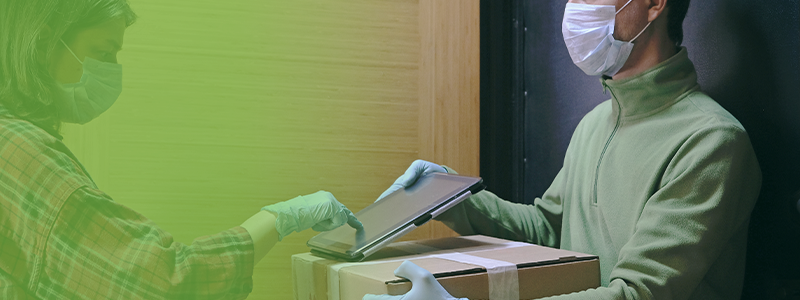
With economic activity grinding to a halt in most industries, transportation and logistics (T&L) organizations are trying to adjust to the volatile market conditions created by the COVID-19 pandemic. With the SARS epidemic estimated to have cost the global economy around $40 billion USD1, the impact of COVID-19 is expected to be substantially higher given its extended reach. It’s not just pandemics that threaten businesses, however. Terrorist events, natural disasters and trade shifts can have equally disruptive effects on business operations and supply chains.
The T&L sector is heavily relied upon on a daily basis, but especially during a global crisis. In fact, a new report has revealed that post-COVID-19, the global logistics market size is projected to grow from $2,734 billion USD in 2020 to $3,215 billion USD by 2021, a year over year (YoY) increase of 17.6%2 with the major drivers being the continued supply of essential goods. The role T&L plays in the supply and delivery of resources means the impact in this sector must be mitigated to enable businesses to mobilize effectively during a global disruption. It’s imperative that now, more than ever, T&L organizations consider how the landscape of their business will change, as demand increases and pressures intensify.
Delivering visibility across the supply chain
Mobile devices and apps, when used in T&L operations, holds the key to visibility across the supply chain and helps businesses to keep up with demands. They achieve this by providing access to real-time asset visibility on everything from drivers to vehicles and their cargo. Improved visibility, from pickup to delivery, is crucial for effective supply chain management and essential for reacting quickly to changing conditions. Innovative mobile technology is at the forefront of tools and solutions that enable T&L organizations to gain end-to-end visibility and control over their supply chain and peripheral operations.
By integrating an effective business mobility strategy, across all devices and backend systems, organizations can improve efficiency, accuracy and timeliness across the delivery process. An effective mobile device strategy will provide insight, from confirmation scans of material being received at the hub or arriving at the depot, through to the state of mobile devices out in the field, and in turn the current location and activities of mobile workers.
During unprecedented and uncertain times, businesses are looking for more real-time data analytics to influence how they adapt to these new challenges. However, a recent SOTI survey revealed that only 1 in 5 companies have total visibility into their mobile and IoT deployments. Modern organizations are looking for ways or tools that can provide actionable insights into the overall health of their mobile deployments in terms of app, device and user analytics. These insights can improve performance and serve customers better, forecasting when to scale capacity up or down and when to adapt operations in response to disruptions. This will ensure there is minimal delay and that there is still a relatively efficient supply chain to meet demands. Access to data and analytics around the most important factors affecting mobile device performance provides T&L organizations with actionable insights that can empower them make more informed decisions around the performance of their business.
Without processes and technology, responding to a disruption is nearly impossible. Be it automating processes and routes, streamlining functions to deal with unprecedented levels of demand, or simply maintaining quality standards in volatile and uncertain times, the need for technology has never been so crucial.
Driving better customer experiences
As lockdown restrictions continue to establish a new normal globally, consumers are becoming more accustomed to the efficiency of shopping online. In fact, global online retail sales have risen dramatically in March 2020, with a 74% growth in average transaction volumes compared with the same period last year, according to data from ACI Worldwide.3 With their expectations continuing to grow at a rapid pace, it is important to ensure that items are delivered on time, without delay. Real-time data enables accurate delivery times and provides a comprehensive overview of delays. With many T&L organizations striving for a high standard of “last-mile” delivery, it becomes imperative that they have visibility into the products they move around, and that they can provide this same visibility to their customers.
If organizations do not leverage an integrated mobile approach to improve the visibility, management and support of their business-critical mobile operations, they run the risk of limiting their ability to swiftly respond to issues, which could directly lead to losses in productivity and revenue. By implementing an effective mobility strategy, T&L organizations can ensure consumer needs are met by delivering end-to-end supply chain visibility. With access to real-time insights, downtime can be minimized and customer service improved as a result.
To future-proof operations, businesses must invest in technology that can connect the disparate parts of their business, deliver on the promise of transparency and improve the customer experience. There is no doubt that COVID-19 will take months to fully respond to and possibly years to recover from. There are already reports which have revealed that more than 80% of companies believe their organization will experience some impact because of disruption due to COVID-19. Of those, 16% of companies reported having already adjusted revenue targets downward by an average of 5.6% because of the pandemic.4
The best thing businesses can do right now is to plan for the future, take proactive steps to stabilize supply chains and review their long-term mobility strategy to safeguard against future disruptions.
- University of Oxford, The economic impact of COVID-19
- MarketWatch, COVID-19 Impact on Logistics & Supply Chain Industry Market by Industry Verticals, Mode of Transport, Region - Global Forecast to 2021Will Saudi Oil Strikes Hamper Supply Chains?
- Essential Retail, Covid-19: Huge growth in eCommerce sales during March
- University of Oxford, The economic impact of COVID-19



